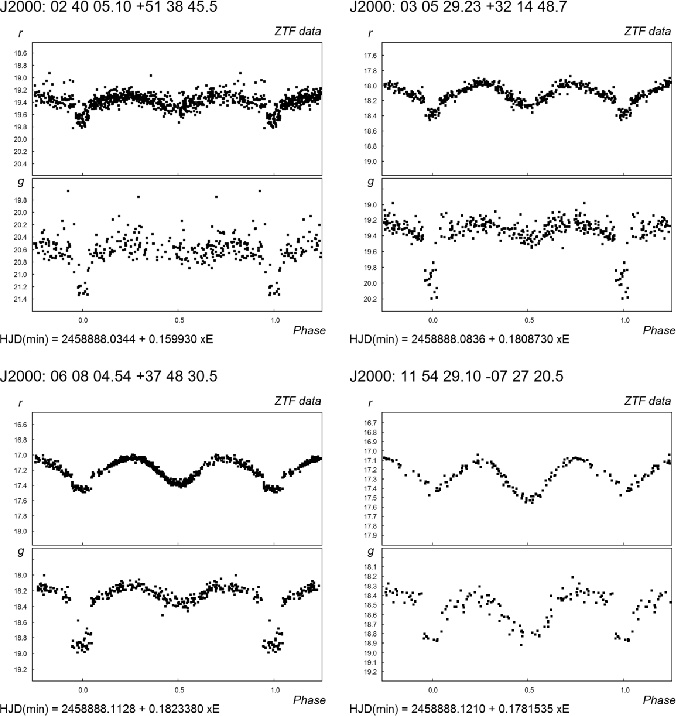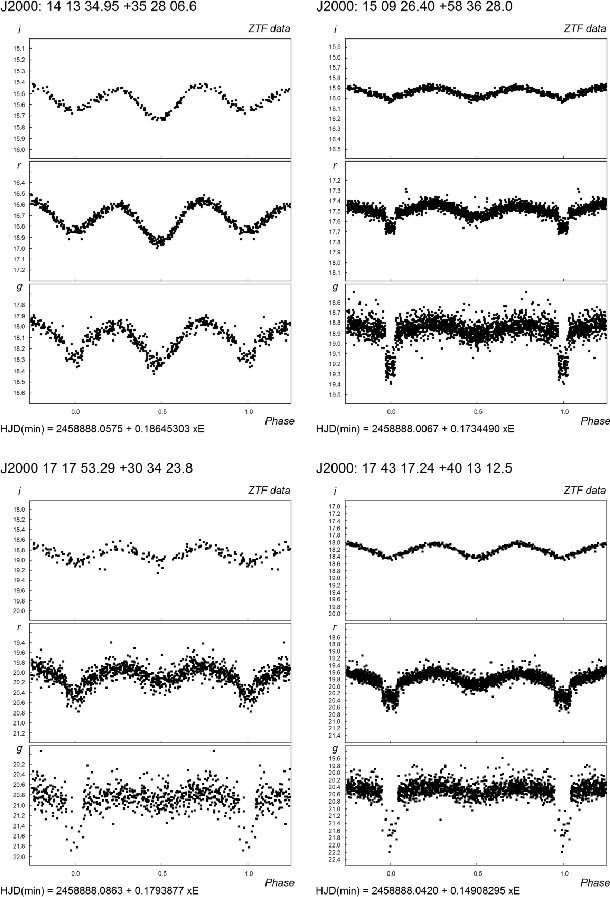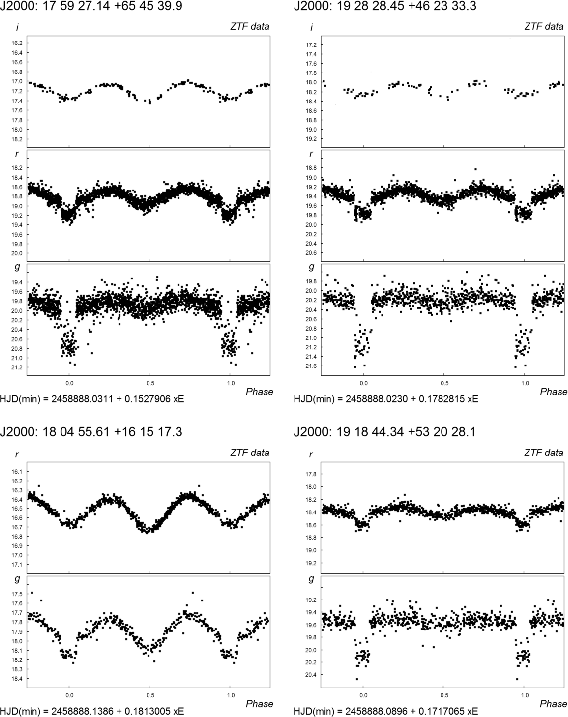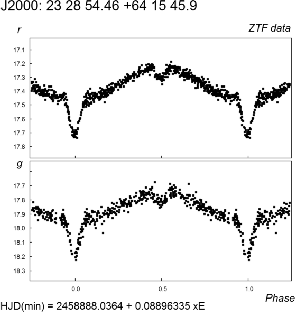|
Peremennye Zvezdy (Variable Stars) 43, No. 1, 2023 Received 18 January; accepted 8 February. |
Article in PDF |
|
DOI: 10.24412/2221-0474-2023-43-1-13
|
A Study of Short-period Eclipsing Binaries
A. V. Khruslov1,2
- Sternberg Astronomical Institute, Moscow State University,
Universitetskij pr. 13, Moscow 119992, Russia; khruslov@bk.ru
- Institute of Astronomy, Russian Academy of Sciences, Pyatnitskaya str. 48, Moscow 119017, Russia
|
I present a detection of 14 new eclipsing white-dwarf
plus main-sequence binaries. The light curves in different
photometric bands are characterized by different values of the
amplitude of the eclipsing minimum, it is the largest in blue
light ( |
1. Introduction
In this paper, I present my study of 16 short-period eclipsing binaries. Fourteen of them are Algol-type eclipsing binary systems with a white dwarf component (EA/WD classification according to the GCVS, Samus et al., 2017), the second component being a main-sequence star.
The difficulty in identifying such systems is that the radiation is dominated by the red component, and it is impossible to detect the white dwarf spectroscopically. At the same time, the white dwarf can be confidently identified by characteristic eclipses in the blue band.
All the stars in this paper were first discovered in the CSS or ZTF surveys (Drake et al., 2014; Chen et al., 2020) as EW
eclipsing binaries with shortest periods for stars of this type.
For the EA/WD stars, this is because Catalina observations were
made in red light, and in ZTF, variables were probably classified
according to the most complete series of observations in the
![]() band. Our study of data in all photometric bands of the ZTF
survey permits us to detect Algol-type eclipses in the light
curves of these stars, clearly seen in blue light.
band. Our study of data in all photometric bands of the ZTF
survey permits us to detect Algol-type eclipses in the light
curves of these stars, clearly seen in blue light.
The light curves of the studied EA/WD stars in different
photometric bands are characterized by different amplitudes of the
Algol-type eclipsing minimum, with the largest amplitude in blue
light (![]() band), significantly lower one in red light (
band), significantly lower one in red light (![]() band),
and no eclipse in infrared light (
band),
and no eclipse in infrared light (![]() band). Outside eclipses, a
double wave is observed, characteristic of ellipsoidal variability
or reflection effect. The ellipsoidal double wave has a deeper
minimum at phase 0.5 and a shallower one at phase 0.0 (that of the
total eclipse); in addition, in most cases, the O'Connell effect
is detected.
band). Outside eclipses, a
double wave is observed, characteristic of ellipsoidal variability
or reflection effect. The ellipsoidal double wave has a deeper
minimum at phase 0.5 and a shallower one at phase 0.0 (that of the
total eclipse); in addition, in most cases, the O'Connell effect
is detected.
Examples of studies of similar binary systems, with white-dwarf and main-sequence components, can be found in Law et al. (2012) (PTF1 J004546.00+415030.0, PTF1 J015256.60+384413.4, and possibly, PTF1 J015524.70+373153.8); Parsons et al. (2013) (SDSS J102857.78+093129.8 and SDSS J130733.49+215636.7); Parsons et al. (2015) (SDSS J002412.87+174531.4, SDSS J101356.32+272410.6, and SDSS J154057.27+370543.4). Photometric data for all the above-mentioned stars are available in the ZTF database.
In the ZTF data for most EA/WD variables, an eclipse is detected
in the ![]() and
and ![]() bands. In two cases (No. 4, No. 5), the eclipse
was detected only in the
bands. In two cases (No. 4, No. 5), the eclipse
was detected only in the ![]() band (a very small
band (a very small ![]() -band eclipse
also for No. 10). On the other hand, SDSS J130733.49+215636.7
showed eclipses in all the three photometric bands. Among the
stars studied in this paper, only one (No. 6) has a suspected
eclipsing minimum in the
-band eclipse
also for No. 10). On the other hand, SDSS J130733.49+215636.7
showed eclipses in all the three photometric bands. Among the
stars studied in this paper, only one (No. 6) has a suspected
eclipsing minimum in the ![]() band.
band.
Two stars, USNO-B1.0 1241-0198455 and USNO-B1.0 1542-0307762 (see Sections 3 and 4), show eclipses of different kind and are possible cataclysmic stars. USNO-B1.0 1241-0198455 features very different shapes and amplitudes of phased light curves in different photometric bands. USNO-B1.0 1542-0307762 has a very short period, its Algol-type light curves in different bands are virtually identical, and additionally, it exhibits a large reflection effect.
For my study of thess stars, I used data of the Zwicky Transient Facility (Bellm et al., 2019; Masci et al., 2019) and the Catalina Sky Survey (Drake et al., 2009 ). I analyzed all observations available for these stars in the ZTF (the SNAD ZTF viewer1, Malanchev et al., 2021) and CSS2online public archives using the period-search software developed by Dr. V.P. Goranskij for Windows environment. The data from the CSS and ZTF surveys for the program stars are available online in the html version of this paper as a zip archive.
The tabulated coordinates of the variable were drawn from the Gaia EDR3 catalogue (Gaia Collaboration, 2021).
2. Eclipsing white-dwarf plus main-sequence binaries
Coordinates (J2000), light elements (period, ![]() , and epoch of
eclipsing Algol-type minimum,
, and epoch of
eclipsing Algol-type minimum, ![]() = HJD-2458888), total duration
of the eclipse (
= HJD-2458888), total duration
of the eclipse (![]() ) and that of the total eclipse (
) and that of the total eclipse (![]() ), color
indices
), color
indices ![]() (according to 2MASS, Skrutskie et al. 2006) and
(according to 2MASS, Skrutskie et al. 2006) and
![]() -
-![]() (according to ZTF), and comments for EA/WD stars are
collected in Table 1.
(according to ZTF), and comments for EA/WD stars are
collected in Table 1.
Information on magnitude range and depth of Minimum I in the ![]() ,
,
![]() , and
, and ![]() bands of ZTF and in the
bands of ZTF and in the ![]() band of CSS photometry
is presented in Table 2. Comments are given for individual stars.
band of CSS photometry
is presented in Table 2. Comments are given for individual stars.
Parameters of the ellipsoidal variability component (variation
amplitude, amount of the O'Connell effect, and phase of Maximum I)
are given in Table 3. The amount of the O'Connell effect is
presented as the magnitude difference in maxima; phase of
Maximum I (the brighter one) is indicated in the Table as "a"
for the maximum at the phase
![]() or "b" for that at
or "b" for that at
![]() . Comments are given for individual stars.
. Comments are given for individual stars.
The phased light curves of all our EA/WD stars, based on ZTF data, are displayed in Figs. 1-4.
| No. | Coordinates, J2000 | Comment | ||||||
| 1 | 02 |
0 |
0.0344 | 0 |
0 |
0 |
1 |
1 |
| 2 | 03 05 29.23 +32 14 48.7 | 0.1808730 | 0.0836 | 0.08 | 0.07 | 0.93 | 1.24 | 1 |
| 3 | 06 08 04.54 +37 48 30.5 | 0.1823380 | 0.1128 | 0.11 | 0.10 | 0.94 | 1.11 | 1 |
| 4 | 11 54 29.10 -07 27 20.5 | 0.1781535 | 0.1210 | 0.10 | 0.08: | 0.91 | 1.27 | 2,3,4 |
| 5 | 14 13 34.95 +35 28 06.6 | 0.18645303 | 0.0575 | 0.10 | 0.09 | 0.89 | 1.38 | 1,2,5 |
| 6 | 15 09 26.40 +58 36 28.0 | 0.1734490 | 0.0067 | 0.06 | 0.05 | 0.89 | 1.37 | 1,6 |
| 7 | 17 17 53.29 +30 34 23.8 | 0.1793877 | 0.0863 | 0.10 | 0.08: | 0.61 | 0.78 | 1 |
| 8 | 17 43 17.24 +40 13 12.5 | 0.14908295 | 0.0420 | 0.095 | 0.07 | 1.04 | 0.67 | 1 |
| 9 | 17 59 27.14 +65 45 39.9 | 0.1527906 | 0.0311 | 0.10 | 0.08 | 1.09 | 1.09 | 1 |
| 10 | 18 04 55.61 +16 15 17.3 | 0.1813005 | 0.1386 | 0.11 | 0.09 | 0.90 | 1.39 | 1,4 |
| 11 | 19 18 44.34 +53 20 28.1 | 0.1717065 | 0.0896 | 0.09 | 0.08 | 0.86 | 1.18 | 1 |
| 12 | 19 28 28.45 +46 23 33.3 | 0.1782815 | 0.0230 | 0.11 | 0.10 | 1.07 | 0.85 | 1 |
| 13 | 19 51 02.52 +51 10 54.2 | 0.1797834 | 0.0590 | 0.10 | 0.09 | 0.74 | 0.89 | 1,6 |
| 14 | 23 40 19.42 +12 24 38.5 | 0.13683955 | 0.0502 | 0.10 | 0.07 | 0.89 | 1.17 | 1,6,7 |
Comments for Table 1.
1. The variable is in the ZTF catalog of periodic variable stars (Chen et al., 2020), type EW.
2. Variability was discovered by Drake et al. (2014, the Catalina Surveys periodic variable stars), they give the type ELL (ellipsoidal variable), it is a candidate ultra-short-period ellipsoidal binary.
3. The variable is in the ZTF catalog of periodic variable stars (Chen et al., 2020), type RSCVN (RS CVn rotational variable), with a twice shorter period.
4. The star is marked in the Gaia DR2 catalog (Gaia Collaboration, 2018) as a variable.
5. The star is in the ASAS-SN Catalog of variable stars, II (Jayasinghe et al., 2019) with the type ROT: (possible rotational variable), with no period given.
6. The star is in the Gaia DR3 catalog of variables (Gaia Collaboration, 2022) as a short-timescale source, with a twice shorter period.
7. The variability was discovered by Drake et al. (2014), the Catalina Surveys periodic variable stars, they give type ELL (ellipsoidal variable).
Additionally, we give the list of cross-identifications for the variables of this section. The stars were identified in the GSC (Morrison et al., 2001) and USNO-B1.0 (Monet et al., 2003) catalogs, and in other catalogs that list these stars as variables.
| Magnitude range | Depth of MinI | |||||||
| No. | ||||||||
| 1 | - | 19.30-19.7 | 20.48-21.3 | - | - | 0.25 | 0.7 | - |
| 2 | - | 17.97-18.39 | 19.25-20.0 | 17.30-17.58 | - | 0.18 | 0.6 | 0.00 |
| 3 | - | 17.04-17.45 | 18.14-18.93 | - | - | 0.17 | 0.60 | - |
| 4 | - | 17.08-17.53 | 18.35-18.85 | 16.67-17.01 | - | 0.00 | 0.35 | 0.10: |
| 5 | 15.42-15.74 | 16.57-16.95 | 17.95-18.33 | 16.34-16.63 | 0.00 | 0.00 | 0.15 | 0.00 |
| 6 | 15.90-16.01 | 17.43-17.67 | 18.80-19.25 | - | 0.03: | 0.14 | 0.35 | - |
| 7 | 18.73-19.20 | 19.88-20.55 | 20.73-21.7 | - | 0.00 | 0.35 | 0.8 | - |
| 8 | 18.05-18.46 | 19.60-20.35 | 20.36-21.6 | 19.03-19.60 | 0.00 | 0.40 | 1.0 | 0.3: |
| 9 | 17.01-17.43 | 18.65-19.22 | 19.77-20.77 | - | 0.00 | 0.30 | 0.77 | - |
| 10 | - | 16.37-16.74 | 17.72-18.15 | - | - | 0.08 | 0.20 | - |
| 11 | - | 18.32-18.62 | 19.49-20.15 | - | - | 0.20 | 0.58 | - |
| 12 | 18.02-18.32 | 19.25-19.80 | 20.10-21.2 | - | 0.00 | 0.35 | 0.95 | - |
| 13 | 17.15-17.44 | 18.30-18.84 | 19.20-20.33 | - | 0.00 | 0.31 | 0.97 | - |
| 14 | 15.26-15.63 | 16.52-17.02 | 17.70-18.53 | 16.09-16.48 | 0.00 | 0.19 | 0.54 | 0.08: |
Comments for Table 2.
No. 2. According to Mount Lemmon data of the Catalina Sky Surveys
(MLS data),
![]() (
(![]() ). Depth of MinI 0.00 (
). Depth of MinI 0.00 (![]() ).
).
No. 13. Type EA/WD+UV. In the ZTF data, two UV Cet type flares
were observed, see Fig. 6. Full magnitude range, with the flares:
![]() (
(![]() ),
),
![]() (
(![]() ).
).
Cross-identifications of the variables.
1. GSC2.3 NBYL026546 = USNO-B1.0 1416-0081817 = ZTFJ024005.10+513845.5
2. GSC2.3 NCLX002963 = USNO-B1.0 1222-0050266 = ZTFJ030529.22+321448.4
3. GSC2.3 N8BE022589 = USNO-B1.0 1278-0157475 = ZTFJ060804.53+374830.3
4. GSC2.3 S4RY006186 = USNO-B1.0 0825-0293169 = ZTFJ115429.08-072720.5 = Gaia DR2 3595130485680186880 = CRTS J115429.1-072720
5. GSC2.3 N69A003049 = USNO-B1.0 1254-0216875 = ZTFJ141334.93+352806.4 = ASASSN-V J141334.94+352806.8 = CRTS J141334.9+352806
6. GSC2.3 N4JP001625 = USNO-B1.0 1486-0224024 =ZTF J150926.26+583628.1 = Gaia DR3 1613395260628589952
7. GSC2.3 N3JW012971 = USNO-B1.0 1205-0261277 = ZTFJ171753.27+303423.8
8. GSC2.3 N3D1004960 = USNO-B1.0 1302-0283064 = ZTFJ174317.23+401313.1
9. GSC2.3 N4EA003607 = USNO-B1.0 1557-0176059 = ZTF J175927.14+654540.4
10. GSC2.3 N1Q0009606 = USNO-B1.0 1062-0295637 = ZTFJ180455.60+161517.5 = Gaia DR2 4501990462045545216
11. GSC2.3 N15V009490 = USNO-B1.0 1433-0308715 = ZTF J191844.32+532028.2
12. GSC2.3 N2JG036643 = USNO-B1.0 1363-0315622 = ZTFJ192828.45+462333.6
13. GSC2.3 N2HO015735 = USNO-B1.0 1411-0325535 = ZTFJ195102.51+511054.3
14. GSC2.3 N034001096 = USNO-B1.0 1024-0771770 = ZTFJ234019.42+122438.8 = Gaia DR3 2763936391281797376 = CRTS J234019.3+122438
| Ellipsoidal amplitude | O'Connell effect, |
Phase | |||||||
| No. | of max. | ||||||||
| 1 | - | 0.22 | 0.17 | - | - | 0.00 | 0.04 | - | a |
| 2 | - | 0.27 | 0.15 | 0.28 | - | 0.02 | 0.00 | 0.02 | a |
| 3 | - | 0.33 | 0.22 | - | - | 0.01 | 0.02 | - | a |
| 4 | - | 0.45 | 0.46 | 0.34 | - | 0.04 | 0.06 | 0.00 | b |
| 5 | 0.32 | 0.38 | 0.38 | 0.29 | 0.05 | 0.04 | 0.05 | 0.01 | b |
| 6 | 0.11 | 0.13 | 0.12 | - | 0.00 | 0.03 | 0.01 | - | a |
| 7 | 0.47 | 0.32 | 0.19 | - | 0.00: | 0.04 | 0.05 | - | b |
| 8 | 0.41 | 0.36 | 0.24 | 0.30 | 0.00: | 0.02 | 0.03 | 0.03 | a |
| 9 | 0.42 | 0.35 | 0.21 | - | 0.07 | 0.04 | 0.04 | - | b |
| 10 | - | 0.37 | 0.38 | - | - | 0.04 | 0.05 | - | b |
| 11 | - | 0.15 | 0.11 | - | - | 0.04 | 0.03 | - | a |
| 12 | 0.30 | 0.25 | 0.17 | - | 0.02 | 0.02 | 0.02 | - | b |
| 13 | 0.29 | 0.22 | 0.13 | - | 0.00: | 0.03 | 0.02 | - | a |
| 14 | 0.37 | 0.47 | 0.33 | 0.35 | 0.04 | 0.07 | 0.07 | 0.03 | a |
Comments for Table 3.
No. 2. Ellipsoidal amplitude 0![]() 31
31 ![]() (MLS); O'Connell
effect:
(MLS); O'Connell
effect:
![]()
![]() (MLS).
(MLS).
No. 9. Phase of MinII
![]() , eccentric binary system.
, eccentric binary system.
No. 14. For CSS data, the phase of maximum is "b".
In the data on one of the stars (No. 13), two flares of the UV
Ceti type were detected. Amplitudes of these flares are near
![]() for observations in the
for observations in the ![]() and
and ![]() bands. Thus, for the
star No.13, the variability type is EA/WD+UV. The light curves of
the flares are displayed in Fig. 5.
bands. Thus, for the
star No.13, the variability type is EA/WD+UV. The light curves of
the flares are displayed in Fig. 5.
The phased light curves for five of the studied stars, based on Catalina surveys (CSS) data, are displayed in Fig. 6. Additionally, for the star No. 2, we used MLS data. According to CSS data, the eclipse is either not detectable or very small and very uncertainly documented.
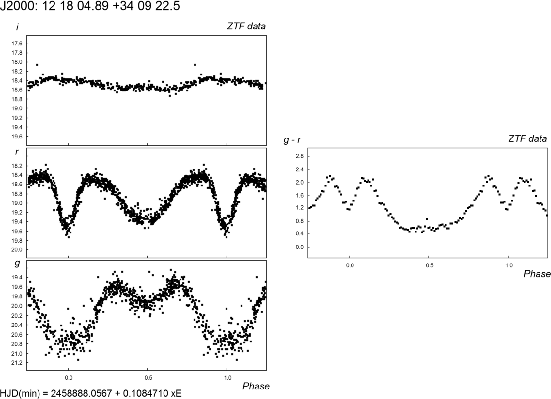 |
Fig. 7. The phased light curves (left) and phased curve of colour index varies (right) of USNO-B1.0 1241-0198455 (ZTF). |
 |
Fig. 7. The phased light curves (left) and phased curve of colour index varies (right) of USNO-B1.0 1241-0198455 (ZTF). |
3. USNO-B1.0 1241-0198455
The variability of USNO-B1.0 1241-0198455 = GSC2.3 N5BD003434 (J2000: 23h28m54.s46, +34°09′22.″5) was discovered by Chen et al. (2020, the ZTF catalog of periodic variable stars). The variable (ZTFJ121804.90+340921.9) was classified as an EW star with the period 0.d1084693. In AAVSO VSX database, the variable was classified as VAR (variable without a known type).
My re-analysis of the ZTF data shows that the light curves differ greatly in different photometric bands. The phased light curves and phased curve of color index variations of USNO-B1.0 1241-0198455, based on ZTF data, are displayed in Fig. 7. The revised light elements are:
The color index varies with the amplitude 1.m5. The phased curve of color-index variations consists of two elements: quasi-sinusoidal variations with the maximum index g – r = 2.1 and the minimum index g – r = 0.6 (in the minimum, there is a long plateau in the phase interval 0.p35 – 0.p65, and a symmetrical narrow minimum, g – r = 1.2, corresponding to Minimum I in the r-band light curve superposed on the maximum of the sinusoidal component, with phases from 0.p89 to 0.p11). However, in the g band at the same phases, the light is constant (g = 20.m8). The plateau in the minimum of the sinusoidal component of the color index is superposed on Minimum II of brightness variability in the r and g bands, and as a result, at this interval, the phased light curves in both bands are identical.
In the i band, the phased light curve is very different from the curves in the r or g bands: is is a quasi-sinusoidal wave of a small amplitude, the phase of maximum is 0.p9 and the phase of minimum is 0.p6 (roughly correlated with the phased curve of color index variations). No eclipsing minimum can be observed in the i band.
Photometric parameters of the light curves are the following:
– in the i band, the magnitude range is 18.m35 – 19.m38, with maximum at phase 0.p92 and minimum at phase 0.p62
– in the r band, the magnitude range is 18.m47 – 19.m55; MinII = 19.m38; phase of maximum I, 0.p17; that of minimum II, 0.p83;
– in the g band, the magnitude range is 19.m55 – 20.m8; MinII = 20.m0; phase of maximum I, 0.p31; that of minimum II, 0.p69.
The eclipse duration in r band, D = 0.p22, is the same as the duration of the possible total eclipse in g band. The mean color indices are J – K = 1.11 (2MASS), g – r = 1.12 (ZTF).
4. USNO-B1.0 1542-0307762
The variability of USNO-B1.0 1542-0307762 = GSC2.3 N1A2083771 (J2000: 23h28m54.s46, +64°1′45.″9) was detected by Chen et al. (2020, the ZTF catalog of periodic variable stars). The variable (ZTFJ232854.43+641545.8) was classified as an EW star with the period 0.d1779266.
I re-analyzed the ZTF data. This star is actually a short-periodic Algol-type eclipsing variable with the period twice shorter than that in the ZTF catalog. The phased light curves of USNO-B1.0 1542-0307762 according to ZTF data are displayed in Fig. 8. The revised light elements are:
The eclipse duration is D = 0p11.
In addition to Algol-type variability, the star shows double-wave variations attributed to ellipsoidal variability or reflection effect.
Photometric parameters of the light curves are the following:
– in the r band, the magnitude range is 17.m23 – 17.m72; depth of Minimum I is 0.m28; depth of MinII is 0.m08; amplitude of the double-wave component is 0.m23.
– in the g band, the magnitude range is 17.m74 – 18.m21; depth of MinI, 0.m29; depth of MinII, 0.m08; amplitude of the double-wave component is 0.m20.
The mean color index is g – r = 0.50 (ZTF).
Acknowledgments: The author wishes to thank Dr. V.P.
Goranskij for providing his software. Thanks are due to
Dr. N.N. Samus for helpful discussions.
References:
Bellm, E. C., Kulkarni, S. R., Graham, M. J., 2019, Publ. Astron. Soc. Pacific, 131, 018002
Chen, X., Wang, S., Deng, L., et al., 2020, Astrophys. J. Suppl. Ser., 249, id. 18
Drake, A. J., Djorgovski, S. G., Mahabal, A., et al., 2009, Astrophys. J., 696, 870
Drake, A. J., Graham, M. J., Djorgovski, S. G., et al., 2014, Astrophys. J. Suppl. Ser., 231, 29
Gaia Collaboration: Brown, A. G. A., Vallenari, A., Prusti, T., et al. 2021, Astron. & Astrophys., 649, article id. A1
Gaia Collaboration: Brown, A. G. A., Vallenari, A., Prusti, T., et al., 2018, Astron. & Astrophys., 616, article id. A1
Gaia Collaboration, 2022, VizieR On-line Data Catalog: I/358
Jayasinghe, T., Stanek. K. Z., Kochanek, C. S., et al., 2019, Mon. Notices Roy. Astron. Soc., 486, 1907
Law, N. M., Kraus, A. L., Street, R., et al., 2012, Astrophys. J., 757, article id. 133
Malanchev, K. L., Pruzhinskaya, M. V., Korolev, V. S., et al., 2021, Mon. Not. Roy. Astron. Soc., 502, 5147
Masci, F. J., Laher, R. R., Rusholme, B., 2019, Publ. Astron. Soc. Pacific, 131, 018003
Monet, D. G., Levine, S. E., Canzian, B., et al., 2003, Astron. J., 125, 984
Morrison, J. E., Röser, S., McLean, B., et al., 2001, Astron. J., 121, 1752
Parsons, S. G., Gänsicke, B. T., Marsh, T. R., et al., 2013, Mon. Not. R. Astron. Soc., 429, 256
Parsons, S. G., Agurto-Gangas, C., Gänsicke, B. T., et al., 2015, Mon. Not. R. Astron. Soc., 449, 2194
Samus, N. N., Kazarovets, E. V., Durlevich, O. V., Kireeva, N. N., Pastukhova, E. N., 2017, Astron. Rep., 61, 80
Skrutskie, M. F., Cutri, R. M., Stiening, R., et al., 2006, Astron. J., 131, 1163
